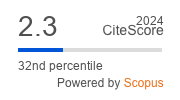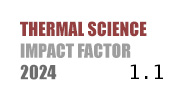THERMAL SCIENCE
International Scientific Journal
Thermal Science - Online First
online first only
The regression analysis and determination of mechanical and physical properties on geopolymer composites under thermal and water curing
ABSTRACT
Increasing costs due to high energy consumption and the release of harmful carbon dioxide (CO2) gases in cement production have made it necessary to explore alternative binders. This study aims to investigate the physical and mechanical properties of geopolymer mortars containing different proportions of pozzolanic wastes under different cure conditions. For this objective, fly ash (FA) obtained from the Sivas/Turkey thermal power plant and blast furnace slag (BFS) obtained from the Bolu and Iskenderun/Turkey ironsteel industries were used as the binding materials. Thermal curing and water curing were applied, and three different molar ratios (8M, 10M, 12M) of sodium hydroxide (NaOH) solution and sodium silicate (Na2SiO3) were used. The results showed that the reaction products, types of alkaline activators, and reaction conditions are important factors in geopolymer mortars. The highest compressive strength recorded was 84.7 MPa in the geopolymer sample which consisted of 95% blast furnace slag (BFS) and 5% fly ash (FA). Furthermore, two different binder additives (marble powder and strontium) were used and their time-dependent effects on the main binder were analysed. In addition, according to the ANOVA statistical results, the R2 value of the independent variables (Molarity, main binder ratios) on the compressive strengths accepted as the dependent variable is 81.7%. The significance value is 0.007, and these results were considered quite significant.
KEYWORDS
PAPER SUBMITTED: 2025-02-16
PAPER REVISED: 2025-04-13
PAPER ACCEPTED: 2025-04-14
PUBLISHED ONLINE: 2025-05-10
- Ganesh, A. C., Muthukannan, M., Development of high performance sustainable optimized fiber reinforced geopolymer concrete and prediction of compressive strength, Journal of Cleaner Production, 282, (2021),124543
- Akbulut, F., Polat, R., , Karagöl, Fatma., Investigation of Using Perlite of Erzurum Pasinler Region in Geopolymer Production, Tr. J. Nature Sci. 10, Issue 1, Page 37-45, (2021)
- Çavdar, A., Yetgin, Ş., Investigation of abrasion resistance of cement mortar with different pozzolanic compositions and subjected to sulfated medium, Construction and Building Materials 24 (4), 461-470,(2010)
- Phoongernkham, T., Maegawa, A., Mishima, N., Hatanaka, S., Chindaprasirt, P., Effects of Sodium Hydroxide and Sodium Silicate Solutions on Compressive and Shear Bond Strengths of FA-GBFS Geopolymer, Construction and Building Materials, 91: 1-8,(2015)
- Abdulrahman, H., Muhamad, R., Visintin, P., Shukri, A.A., Mechanical properties and bond stressslip behaviour of fly ash geopolymer concrete, Construction and Building Materials,327,126909, (2022)
- Casero, M.A.G., Arana, C.D.D., Rodriguez, J.S.B.,Villarejo, L.P., Physical, mechanical and thermal properties of metakaolin-fly ash geopolymers, Sustainable Chemistry and Pharmacy, 26,100620, (2022)
- Nergis, D.D.B., Vizureanu, P., Sandu, A.V., Nergis, D.P.B., Bejinariu, C., XRD and TG-DTA Study of New Phosphate-Based Geopolymers with Coal Ash or Metakaolin as Aluminosilicate Source and Mine Tailings Addition, Materials, 15, 202, (2022)
- Topçu, İ.B., Toprak, M.U., Productıon Of Alkalı Actıvated Lıghtmass Bottom Ash Mortar, Journal of Engineering and Architecture Faculty of Eskişehir Osmangazi University, 22, 2, (2009)
- Koçak, Y., The Effect of Thermic Power Plant Waste Fly Ash on Properties of Portland Cement, Journal of Polytechnic,14,2, 135-140, (2011)
- Kürklü, G., The Investigation of Physical and Mechanical Properties of Geopolymer Mortars with Granulated Blast Furnace Slag Cured at Room Temperature, Afyon Kocatepe University Journal of Science and Engineering,16,025604,356-367, (2016)
- Sağlamtimur, N.D., Geopolymer Buıldıng Materıal Productıon From Wastes Of Bottom Ash And Pumıce, Omer Halisdemir University Journal of Engineering Sciences, 7, 2,590-599, (2018)
- Çavdar, A., and Çavdar Ö., Availability of sedimentary and volcanic rock deposits on Northeastern Turkey as concrete aggregates, Physics and Chemistry of the Earth, Parts A/B/C 134, 103567, (2024)
- Gao, X., Alkali activated slag-fly ash binders: design, modeling and application, Eindhthermal curing University of Technology., Ph.D. Thesis, Netherlands., 229p, 2017
- Huseien , G.F., Sam, A.R.M.S., Alyousef,R., Texture, morphology and strength performance of self-compacting alkali-activated concrete: Role of fly ash as GBFS replacement, Construction and Building Materials,270 121368, (2021)
- Tho-In,T., Sata, V., Boonserm, K., Chindaprasirt, P., Compressive strength and microstructure analysis of geopolymer paste using waste glass powder and fly ash., Journal of Cleaner Production., 172, 2892-2898, (2018)
- Cheah, C.B., Tan,L.E., Ramli,M., The engineering properties and microstructure of sodium carbonate activated fly ash/ slag blended mortars with silica füme, Composites Part B., 160, 558-572, (2019)
- Ling,Y., Wang,K., Li,W., Shi,G., Lu, P., Effect of slag on the mechanical properties and bond strength of fly ashbased engineered geopolymer composites., Composites Part B, 164, 747-757, (2019)
- Kubba, Z., Huseien, G.F., Sam,A.R.M., Shah,K.W., Ismail,M.A.A.M., Tahir,M.M., Jahangir Mirza,J., Impact of curing temperatures and alkaline activators on compressive strength and porosity of ternary blended geopolymer mortars, Case Studies in Construction Materials, 9,(2018)
- Pehlivan, H., Nano silica added trachytic tuff based geopolymer mortars investigation of properties in different curing environment, Gümüşhane University Journal of Science and Technology, 13(3), 580- 594, (2023)
- Eryılmaz, K., Polat,R., Karagöl,F., Turhan,D.,Investigation of Usability of Aggregates Obtained from Geopolymer Concrete Wastes in Geopolymer Concrete, Journal of the Institute of Science and Technology, 13(1), 419-431, (2023)
- Topçu, İ.B., Sofuoğlu, T., Evaluation of Unit Mass and Compressive Strength of Geopolymer Mortars Obtained with Press Filter Waste and Fly Ash under Different Conditions, El-Cezerî Journal of Science and Engineering,7,2, (2020)
- Durak,U., Şimşek,A.A., Investigation of The Use of Waste Iron Powder Instead of Aggregate in Fly Ash and Blast Furnace Slag Based Geopolymer Systems, Journal of The Institute of Science and Technology, 5(2), 812-828, (2022)
- Kalaycıklı,I,E. The Varıatıon Of Compressıve Strength And Durabılıty Performance Of Dıfferent Geopolymer Concrete Wıth Tıme (M.Sc. Thesis). Istanbul Gelısım Unıversity, Instıtute Of Scıence, January 2020
- Altındal,I., The Change Of Compressıve Strength Of Dıfferent Geopolymer Concretes Under Dıfferent Curıng Condıtıons (M.Sc. Thesis), Istanbul Gelısım Unıversity, Instıtute Of Scıence, January 2020
- Lıban.L.R., Desıgn Of Zeolıte Based Geopolymer Mortars Wıth Fly Ash And Lımestone Addıtıves By Taguchı Method, Ph. D Thesıs, Konya Technical University, Institute of Graduate Studies, Department of Civil Engineering,2022
- Şenol,A.F., Properties of Geopolymer Mortar and Concrete Produced with Industrial Waste Powders, 2nd International Conference on Innovative Academic Studies, 28 - 31, Türkiye, 2023
- Kop, M., Yazıcıoğlu, S., Mechanical Properties of Fly Ash and Blast Furnace Slag Based Geopolymer Mortars in Thermal Curing Environment, Gazi University Journal of Science, 11(3): 756-765 (2023)
- Nagajothi, S. Elavenil,S., Effect of GGBS Addition on Reactivity and Microstructure Properties of Ambient Cured Fly Ash Based Geopolymer Concrete, Silicon, 13, 507-516 (2021). doi.org/10.1007/s12633-020-00470-w
- Zhuang X.Y, Liang C, Komarneni S, Zhou CH, Tong DS, Yang HM, Yu WH, Wang H (2016). Fly ash based geopolymer: clean production, properties and applications. J Clean Prod., 125:253-267
- Yaprak H, Alnkaa A, Memis, et al. Effects of different curing conditions on the properties of geopolymeric mortar. MOJ Civil Eng. 5(1), (2019), 45-50
- Yilmazoglu, A, Yildirim, ST, Behçet, ÖF, Yıldız, S. Performance evaluation of fly ash and ground granulated blast furnace slag-based geopolymer concrete: A comparative study. Structural Concrete, (2022), 23: 3898- 3915
- Kretzer M.B, Effting C, Schwaab S, Schackow A. Hybrid geopolymer-cement coating mortar optimized based on metakaolin, fly ash, and granulated blast furnace slag. Cleaner Engineering and Technology, (4), (2021), 100153
- Liu,K. Zhang,Z. Sun,J. Advances in Understanding the Alkali-Activated Metallurgical Slag, Advances in Civil Engineering, vol. 2021, 8795588, 16, 2021. doi.org/10.1155/2021/8795588
- Tsai C.J, Huang R, Lin W.T, Wang H.N. Mechanical and cementitious characteristics of ground granulated blast furnace slag and basic oxygen furnace slag blended mortar, Materials and Design, 60, (2014), 267-273
- Mohammed D.T, Yaltay N. Strength and elevated temperature resistance properties of the geopolymer paste produced with ground granulated blast furnace slag and pumice powder. Ain Shams Engineering Journal, 15, (3), 2024, 102483
- Chindaprasirt P, Jaturapitakkul C, Chalee W, Rattanasak U. Comparative study on the characteristics of fly ash and bottom ash geopolymers. Waste Management, 29, (2), (2009), 539-543
- Tu W, Fang G, Dong B, Hu Y, Zhang M. Behaviour of alkali-activated fly ash-slag paste at elevated temperatures: An experimental study. Cement and Concrete Composites, 147, (2024), 105438
- Matsimbe J, Dinka M, Olukanni D, Musonda I, Performance evaluation and mix design of ambientcured fly ash-phosphogypsum blended geopolymer paste and mortar. Results in Engineering, 24, (2024), 103280
- Karongkong L,L, Setiawan A,A, Hardjasaputra H, Predicting of geopolymer concrete compressive strength using multiple linear regression method. International Journal of Applied Science and Engineering, 19(2), 2021272, March 24, 2022
- Ozturk S. Application of ANOVA and Taguchi Methods for Evaluation of the Surface Roughness of Stellite-6 Coating Material, Materials Testing, vol. 56, no. 11-12, (2014), pp. 1015-1020. doi.org/10.3139/120.110665
- Radulovic R.M,et al., Sustaınabılıty Aspect Of Possıble Materıal Substıtutıon In Constructıon Industry, Thermal Scıence, (2023), 27, 6B, 4961-4973
- Kaya M, Uysal M, Yılmaz K. Investigation of the relationship between strength, curing temperature and void ratio in geopolymer mortars using variance analysis. Sakarya University Science Institute Journal, 22 (2), 248~256, (2018)
- Öznur Öz H., Güneş M., Mechanical and microstructural properties of engineered cement based composites and fly ash and slag based engineered geopolymer composites, NOHU J. Eng. Sci., (2023),12(2), 452-471
- Çınar, M., Erbaşı B., Investıgatıon of the usabılıty of geopolymers in geotechnical applications: a literature study, KSU J Eng Sci, 25(4), 2022
- Nuruddin MFN, Kusbiantoro AK, Qazi SQ, Darmawan MSD, Husin NAH., Development of geopolymer concrete with different curing conditions. IPTEK J Technol Sci. (2011), doi.org/10.12962/J20882033.V22I1.54
- Azarsa P, Gupta R Comparative study involving effect of curing regime on elastic modulus of geopolymer concrete. Buildings 10(6):101. (2020), doi.org/10.3390/BUILDINGS10060101
- Albitar M, Visintin P, Mohamed Ali MS, Drechsler M., Assessing behaviour of fresh and hardened geopolymer concrete mixed with class-F fly ash. KSCE J Civ Eng 19(5):1445-1455. (2015), doi.org/10.1007/S12205-014-1254-Z/METRICS
- Mohammed, D.T. ve Yaltay, N. (2024). Strength and elevated temperature resistance properties of the geopolymer paste produced with ground granulated blast furnace slag and pumice powder. Ain Shams Engineering Journal, 15,3, 102483

